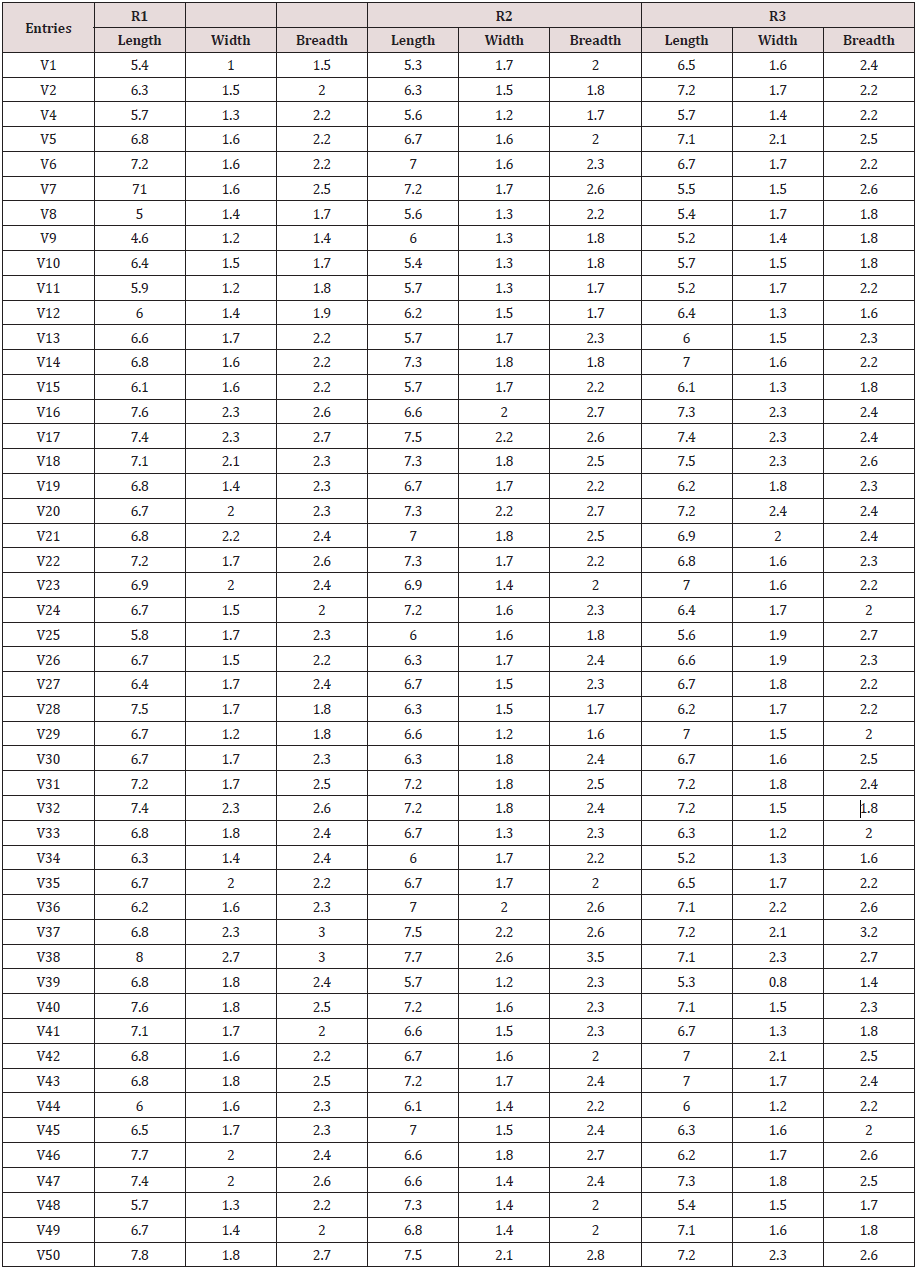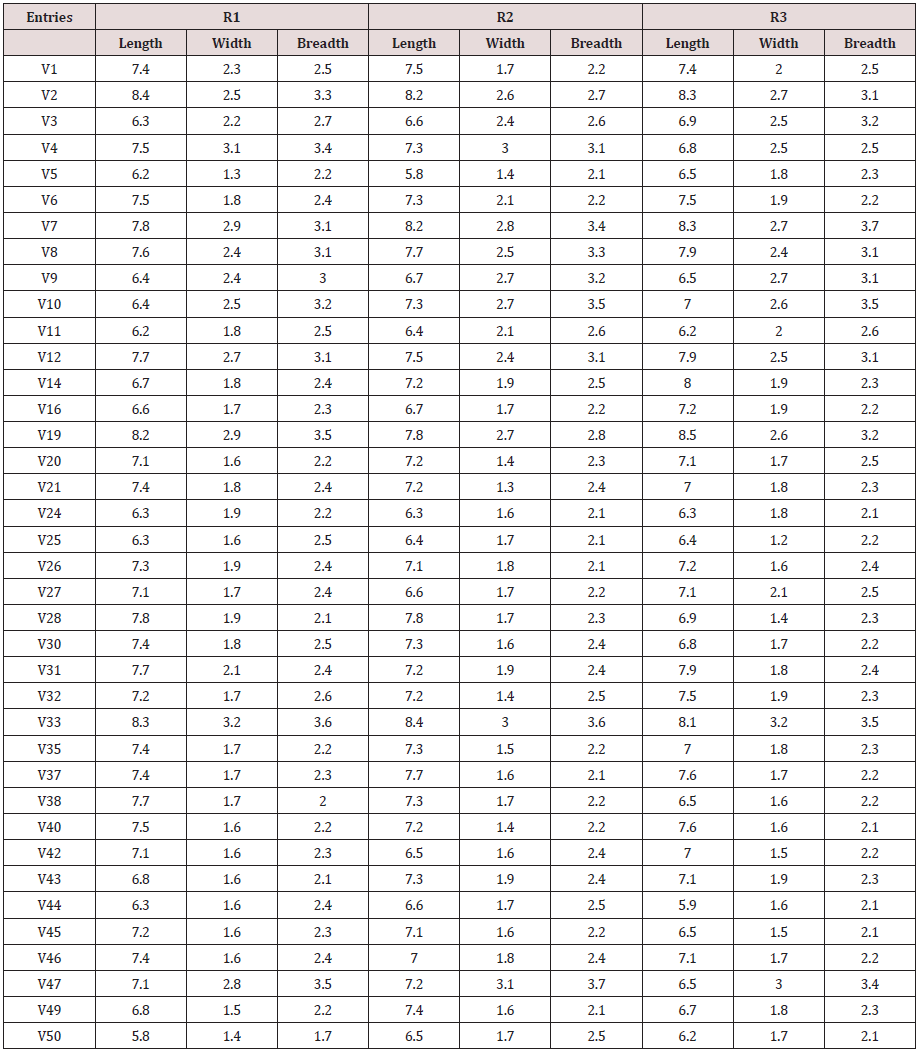
Lupine Publishers Group
Lupine Publishers
Menu
ISSN: 2637-4676
Research Article(ISSN: 2637-4676) 
Comprehensive Analysis of Effect of Submergence on Rice Grain Quality Volume 5 - Issue 5
Mubashar Hussain1*, Nauman Liaqat2, Muhammad Bilal3 and Hamza Armghan Noushahi4
- 1Rice Research Institute, Kala Shah Kaku, Lahore, Pakistan
- 2Department of Agronomy, Pakistan
- 3Department of Entomology, Pakistan
- 4College of Plant Science and Technology, China
Received: December 08, 2018; Published: December 13, 2018
Corresponding author: Mubashar Hussain, Rice Research Institute, Kala Shah Kaku, Lahore, Pakistan
DOI: 10.32474/CIACR.2018.05.000223
Abstract
Flash flooding is one of the major problems in rice growing areas of South and Southeast Asia and it severely limits rice yield in these areas. This experiment was performed to check cultivated varieties with resistance against submergence and check best varieties which give better grain quality after affected by submergence. Chenab Basmati one of the cultivated varieties proved best performer in this experiment and is recommended for cultivation in areas affected by flood in Pakistan.
Introduction
Rice is one of the important crops in cereals. Rice is staple food of 50% population all around the world. Its higher production and good taste are two main parameters for many breeding projects but, in contrary to disease and insect resistance, grain yield and quality are both managed by quantitative trait loci (QTLs) highlighting continuous phenotypic difference in rice offspring [1]. So, it is hard for breeders to upgrade rice grain yield and quality using conventional techniques, due to a lack of distinct phenotypic segregation in the offspring. As rice grain quality is an endosperm characteristic, its heredity can be more complex because the genetic expression of an endosperm trait in cereal seeds is conditioned not only by the triploid endosperm genotype, but also by the diploid maternal genotype and any additional possible cytoplasmic differences [2-4]. Quality of rice grain comprises of cooking, milling, appearance and nutritional qualities. But appearance and cooking quality is mostly focused by people [5]. The appearance quality is often judged in China by the percentage of grain with a white core and a square of white core. Climate change is enhancing submergence stress, which is one of the main hurdles in increasing rice yield in rice growing areas of world. The most common and devastating type of flooding is short-time inundation (up to 2 weeks), also known as flash floods. 20 million hectare of rice growing area is affected by this kind of flooding in Asia (excepted China) as well as many lowland areas of Africa [6-10]. Moreover, due to disastrous effects from climate change, these seasonal flash floods are adversely unpredictable and can occur at any growth period of the rice crop [11]. Rice is submerged in monsoon season in South and Southeast Asia, which adversely limits rice yield and causes one billion U.S dollars losses annually [12].
Material and Methods
There were two sets of genotypes used in this experiment 1st set was grown in control environment, while 2nd was grown in submerged environment in water tank (Table 1). Screw guage was used to measure the grain dimensions like length, width and breadth of controlled and submerged material to study the effect of submergence on grain length, width, breadth and other quality parameters (Table 2).
Material
(Table 3).
Results and Discussion
Submerged genotypes showed great amount of difference among each other in three characteristics of grain width, length and breadth. Genotype 2 showed highest value of mean in case of grain length and maintained 8th rank in grain width. On other hand genotype 5 showed less gain in grain length. In case of grain width genotype 33 gave maximum width and ranked 2nd in case of grain length. Similarly, smallest mean of grain width was shown by genotype 42. Genotype 33 highlighted maximum grain breadth while genotype 31 was lowest ranked with minimum grain breadth.
Overall, genotype 33 gave best results and proved best performer under submergence because it secured 1st position in case of grain width and breadth and at 2nd position in case of grain length. On other hand, if we compare the grain width, breadth and length of genotypes 33 between controls and submerged, we conclude that submerged genotype is enough close to control. So, genotype 33 (Chenab Basmati) is recommended for cultivation in areas affected by flash flooding in Pakistan. While genotype 42 was poor performer because of minimum values for grain length, width and breadth in comparison to all submerged genotypes as well as its control.
Appendix
References
- Akinwale MG, Akinyele BO, Odiyi AC, Nwilene F, Gregorio G, et al. (2012) Phenotypic screening of Nigerian rainfed lowland mega rice varieties for submergence tolerance. In Proceedings of the world congress on Engineering 1: 4-6.
- Fukao T, Yeung E, Bailey Serres J (2011) The submergence tolerance regulator SUB1A mediates crosstalk between submergence and drought tolerance in rice. The Plant Cell pp. 110.
- Neeraja CN, Maghirang Rodriguez R, Pamplona A, Heuer S, Collard BC, et al. (2007) A marker-assisted backcross approach for developing submergence-tolerant rice cultivars. Theoretical and Applied Genetics 115(6): 767-776.
- Manangkil OE, Vu HTT, Yoshida S, Mori N, Nakamura C (2008) A simple, rapid and reliable bioassay for evaluating seedling vigor under submergence in indica and japonica rice (Oryza sativa L.). euphytica 163(2): 267-274.
- Manzanilla DO, Paris TR, Vergara GV, Ismail AM, Pandey S, et al. (2011) Submergence risks and farmers preferences: implications for breeding Sub1 rice in Southeast Asia. Agricultural Systems 104(4): 335-347.
- Nawarathna RN, Perera ALT, Samarasinghe WLG (2014) Screening of BC1F1 population (BG 379-2/IR 07F102//BG 379-2) of rice (Oryza sativa L.) for submergence tolerance using molecular markers. Journal of Agricultural Sciences 9(3).
- Ranawake AL, Amarasinghe UGS, Senanayake SGJN (2014) Submergence tolerance of some modern rice cultivars at seedling and vegetative stages. Journal of Crop and Weed 10(2): 240-247.
- Shelley IJ, Takahashi Nosaka M, Kano Nakata M, Haque MS, Inukai Y (2016) Rice cultivation in Bangladesh: present scenario, problems, and prospects. Journal of International Cooperation for Agricultural Development 14: 20-29.
- Singh S, Mackill DJ, Ismail AM (2014) Physiological basis of tolerance to complete submergence in rice involves genetic factors in addition to the SUB1 gene. AoB Plants 3: 6.
- Nelson Erik (2009) Modeling multiple ecosystem services, biodiversity conservation, commodity production, and tradeoffs at landscape scales. Frontiers in Ecology and the Environment 7(1): 4-11.
- Tews J, Brose U, Grimm V, Tielbörger K, Wichmann MC, et al. (2004) Animal species diversity driven by habitat heterogeneity/diversity: the importance of keystone structures. Journal of biogeography 31(1): 79- 92.
- Das KK, Panda D, Sarkar RK, Reddy JN, Ismail AM (2009) Submergence tolerance in relation to variable floodwater conditions in rice. Environmental and Experimental Botany 66(3): 425-434.

Top Editors
-

Mark E Smith
Bio chemistry
University of Texas Medical Branch, USA -

Lawrence A Presley
Department of Criminal Justice
Liberty University, USA -

Thomas W Miller
Department of Psychiatry
University of Kentucky, USA -

Gjumrakch Aliev
Department of Medicine
Gally International Biomedical Research & Consulting LLC, USA -

Christopher Bryant
Department of Urbanisation and Agricultural
Montreal university, USA -

Robert William Frare
Oral & Maxillofacial Pathology
New York University, USA -

Rudolph Modesto Navari
Gastroenterology and Hepatology
University of Alabama, UK -

Andrew Hague
Department of Medicine
Universities of Bradford, UK -

George Gregory Buttigieg
Maltese College of Obstetrics and Gynaecology, Europe -

Chen-Hsiung Yeh
Oncology
Circulogene Theranostics, England -
.png)
Emilio Bucio-Carrillo
Radiation Chemistry
National University of Mexico, USA -
.jpg)
Casey J Grenier
Analytical Chemistry
Wentworth Institute of Technology, USA -
Hany Atalah
Minimally Invasive Surgery
Mercer University school of Medicine, USA -

Abu-Hussein Muhamad
Pediatric Dentistry
University of Athens , Greece

The annual scholar awards from Lupine Publishers honor a selected number Read More...















